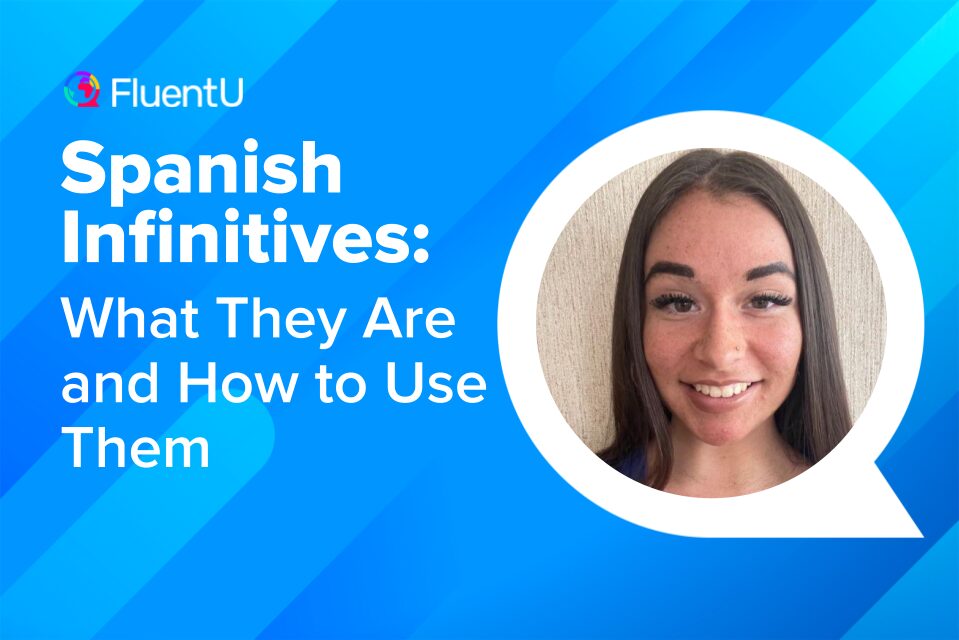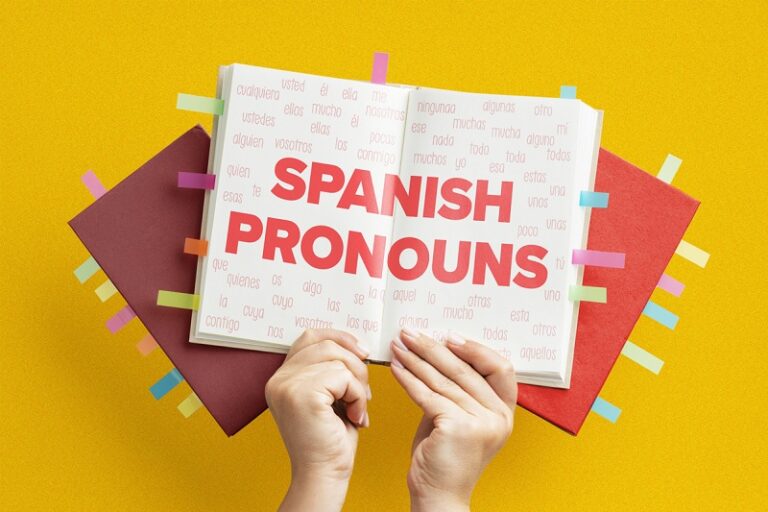Spanish Infinitives: What They Are and How to Use Them

Spanish infinitives—also known as “dictionary form” verbs—are verbs that end in -er, -ar or -ir. They’re the verbs before the endings are removed and conjugated.
Aside from being how verbs appear in dictionaries, infinitives are also used in daily life. So today, we’ll uncover when and how to use them.
Download: This blog post is available as a convenient and portable PDF that you can take anywhere. Click here to get a copy. (Download)
What Are Spanish Infinitives?
Spanish infinitive verbs are the basic verb forms that you see listed in a dictionary before they have been conjugated.
The infinitive always informs us about an action, but in their original form, they don’t tell us any more information.
Infinitive verbs in Spanish are the equivalent of an English verb preceded by to. For example: estudiar means “to study” in English.
The 3 Types of Spanish Infinitives
In Spanish, infinitive verbs always end in -er, -ar or -ir.
For example:
It’s important to remember that infinitives by themselves tell us what the action is, but they don’t tell us who’s doing it or when they’re doing it (past, present, future, etc.).
If I want to say “I’m speaking,” for example, I would need to conjugate hablar in the present tense ( yo hablo ) or present progressive tense ( estoy hablando ).
Some verbs are regular and follow specific conjugation patterns. Others are irregular and have to be memorized separately.
Common Spanish Infinitives
Here are 10 of the most common -ir, -ar and -er Spanish infinitive verbs.
Common -ir Verbs
| Spanish -ir Verbs | English Translation |
|---|---|
| Vivir | To live |
| Escribir * | To write |
| Abrir * | To open |
| Decidir | To decide |
| Describir * | To describe |
| Existir | To exist |
| Recibir | To receive |
| Permitir | To allow |
| Compartir | To share |
| Subir | To go up, to get on |
*Note that escribir, abrir and describir are all regular -ir verbs, however they have irregular past participles escrito (escribir), abierto (abrir) and descrito (describir).
To learn more about -ir verbs, check out this guide:
24 Most Common IR Verbs in Spanish | FluentU Spanish Blog
Spanish IR verbs are extremely common—which is why it pays to know how to use them! In this guide, we’ll not only show you how to conjugate IR verbs in Spanish, but…
Common -ar Verbs
| Spanish -ar Verbs | English Translation |
|---|---|
| Hablar | To talk, to speak |
| Amar | To love |
| Llamar | To call |
| Descansar | To rest |
| Escuchar | To listen |
| Ayudar | To help |
| Esperar | To wait |
| Limpiar | To clean |
| Estudiar | To study |
| Bailar | To dance |
Here’s a list of -ar verbs to learn more:
120 Most Common AR Verbs in Spanish and How to Conjugate Them | FluentU Spanish Blog
Spanish -ar verbs account for the majority of verbs in the language. That’s why it’s important to know not only how to conjugate them but also what the most common regular…
Common -er Verbs
| Spanish -er Verbs | English Translation |
|---|---|
| Deber | To have to, to must, to owe |
| Beber | To drink |
| Comer | To eat |
| Aprender | To learn |
| Comprender | To understand |
| Correr | To run |
| Vender | To sell |
| Sorprender | To surprise |
| Prometer | To promise |
| Esconder | To hide |
Click here for more -er verbs:
35 Most Common ER Verbs in Spanish | FluentU Spanish Blog
ER verbs in Spanish might seem tricky, but this post will help you get the hang of them! Start with these 35 common regular, irregular and stem-changing verbs, such as…
Common Irregular Verbs
| Irregular Spanish Verbs | English Translation |
|---|---|
| Decir | To say |
| Ir | To go |
| Pedir | To ask for |
| Venir | To come |
| Dormir | To sleep |
| Oír | To hear |
| Estar | To be |
| Llegar | To arrive |
| Abrazar | To hug |
| Dar | To give |
| Gustar | To like |
| Pensar | To think |
| Ser | To be |
| Tener | To have |
| Hacer | To do, to make |
| Haber | To have, to be |
| Conocer | To know |
| Saber | To know |
| Querer | To want |
| Ver | To see |
Here are more important irregular verbs to know:
20 Most Common Irregular Verbs in Spanish | FluentU Spanish Blog
Irregular verbs in Spanish are extremely common, so they’re essential to know. Click here to learn 20 of the most useful irregular Spanish verbs, such as “ser,” “estar,”…
When to Use Spanish Infinitives
1. After conjugated verbs
As you learn new verbs in Spanish, you’ll find that many of them can be followed by infinitives. Often, the English version of these infinitives translates as to + verb.
- Quiero comprar un billete. — I want to buy a ticket.
- Prefiero volar. — I prefer to fly.
- Odio bailar. — I hate dancing.
- No sé nadar. — I don’t know how to swim.
You’ll also encounter many verbs that “go with” a preposition (a small word like a, en, etc.) and are then followed by an infinitive.
- Voy a comer. — I’m going to eat.
- Empezamos a leer. — We’re starting to read.
- Acabo de estudiar. — I just studied.
- Estoy pensando en ir a México en julio. — I’m thinking of going to Mexico in July.
It’s best to learn such verbs as short phrases, along with their prepositions. The use of the preposition with each verb should feel automatic.
2. As nouns
Infinitives come in handy when you want to talk about an action in a general way.
In English, we would often use a gerund (a noun made from a verb ending in “-ing”) in such cases.
For example:
- Estudiar español es interesante. — Studying Spanish is interesting.
- Jugar al ajedrez es divertido. — Playing chess is fun.
- El saber proviene de la experiencia. — Knowing (wisdom) comes from experience.
In these cases, the infinitive is grammatically functioning as a noun and the subject of the sentence, that is, it’s the “thing” that’s performing an “action.”
You can use infinitives in this way when you’re making broad statements about what an action is like, or what it does.
You’ve probably also learned the phrase me gusta…, which means “I like…” or literally “… pleases me.”
You can use an infinitive in that blank to talk about actions that you like.
- Me gusta caminar. — I like to walk.
- Me gusta volar. — I like to fly.
- Me gusta leer. — I like to read.
What activities do you like to do? You can explain with the above constructions.
3. To express obligation
When somebody needs to do something, you can conjugate the verb tener (to have), then add the word que and an infinitive verb.
- Tenemos que irnos. — We have to go.
- Tengo que leer. — I have to read.
- Tienes que ser bueno. — You have to be good.
- Tenéis que ver eso. — You guys have to see that.
If you want to talk in a general way about some action needing to happen, you can use the construction hay + que + infinitive.
This can be kind of a sneaky way of saying that something needs to be taken care of without explicitly saying who should do it.
In English, we often rework such a sentence into the passive voice to express the idea.
- Hay que sacar la basura. — The trash needs to be taken out.
- Hay que limpiar la ventana. — The window needs to be cleaned.
- Hay que bañarse. — A shower has to be taken.
4. After prepositions
Prepositions can of course also show up in Spanish without any verb before them. When you want to put a verb after the preposition, you’ll use the infinitive form.
Often, the English equivalent makes use of the “-ing” form of the verb instead.
- Al hablar con ella, entendí todo. — Upon speaking with her, I understood everything.
- Gracias por escuchar. — Thanks for listening.
- Para sacar una buena nota, tienes que estudiar. — To get a good grade, you need to study.
5. In written signs
If you’ve learned the command forms (imperative mood) of verbs, you’ve probably wondered why there are written signs in Spanish without those forms.
You’re probably seeing signs that say things like:
- No fumar — No smoking
- No tocar — Don’t touch
It’s true that in conversation you would say something like “¡No fumes!“ (Don’t smoke!) or “No toques eso” (Don’t touch that).
But it’s quite common to just use the infinitive on signs. This use is pretty easy to notice and recognize. It just expresses the general idea that the action of the verb shouldn’t be happening here.
How to Study Spanish Infinitive Verbs
The best way to get a feel for how infinitive verbs function in everyday speech and writing is to start seeing and hearing how they’re used in context.
If you want to see the infinitive in action, you can get a lot of helpful exposure from Spanish language literature and media.
You can even find videos of Spanish speakers on YouTube or other streaming services. The infinitive comes up frequently in conversations and dialogue.
If you’d like to use videos as a more focused learning method, FluentU is a language learning program that allows you to watch videos in Spanish made by and for native speakers.
FluentU takes authentic videos—like music videos, movie trailers, news and inspiring talks—and turns them into personalized language learning lessons.
You can try FluentU for free for 2 weeks. Check out the website or download the iOS app or Android app.
P.S. If you decide to sign up now, you can take advantage of our current sale!

The infinitive is probably the easiest verb form to learn just from exposure. You don’t have to learn conjugations—only how these words work in sentences and the syntax around them.
To further study infinitive verbs and how they can change based on the way they’re used, you could check out this video from the FluentU Spanish YouTube channel:
If you need a break from studying the hundreds of forms that Spanish conjugations can take, perhaps some work with these nice, plain infinitives will seem relaxing.
See if you can use them in some sample sentences like the ones above, and stay alert to such instances of -ar, -er and -ir endings in constructions as you continue your Spanish adventure.
Download: This blog post is available as a convenient and portable PDF that you can take anywhere. Click here to get a copy. (Download)
And One More Thing…
If you've made it this far that means you probably enjoy learning Spanish with engaging material and will then love FluentU.
Other sites use scripted content. FluentU uses a natural approach that helps you ease into the Spanish language and culture over time. You’ll learn Spanish as it’s actually spoken by real people.
FluentU has a wide variety of videos, as you can see here:

FluentU brings native videos within reach with interactive transcripts. You can tap on any word to look it up instantly. Every definition has examples that have been written to help you understand how the word is used. If you see an interesting word you don’t know, you can add it to a vocab list.

Review a complete interactive transcript under the Dialogue tab, and find words and phrases listed under Vocab.

Learn all the vocabulary in any video with FluentU’s robust learning engine. Swipe left or right to see more examples of the word you’re on.

The best part is that FluentU keeps track of the vocabulary that you’re learning, and gives you extra practice with difficult words. It'll even remind you when it’s time to review what you’ve learned. Every learner has a truly personalized experience, even if they’re learning with the same video.
Start using the FluentU website on your computer or tablet or, better yet, download the FluentU app from the iTunes or Google Play store. Click here to take advantage of our current sale! (Expires at the end of this month.)







